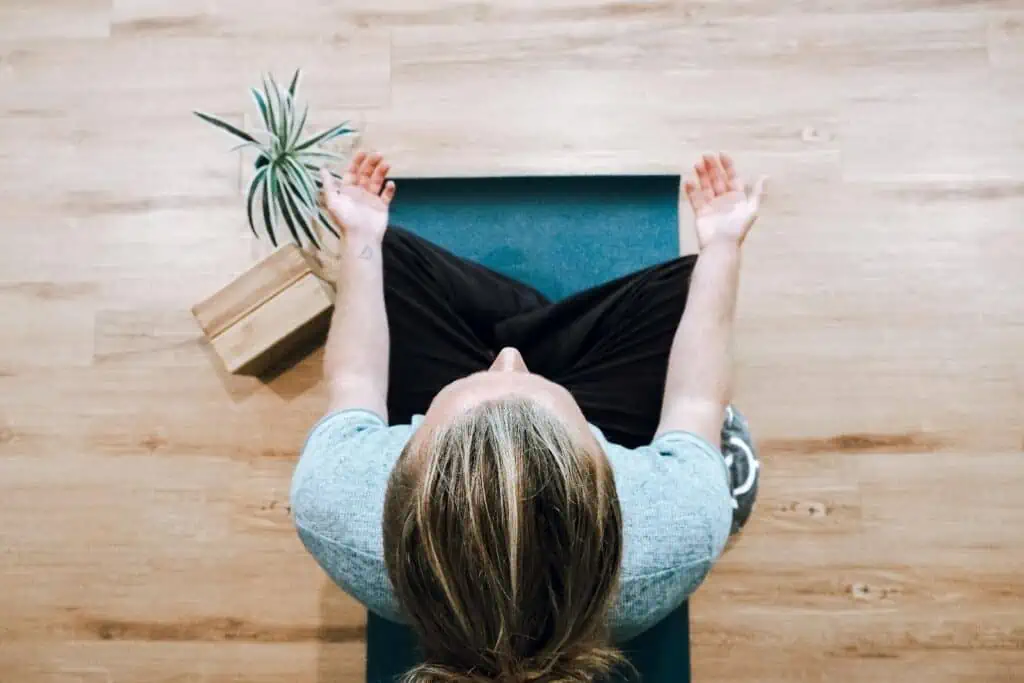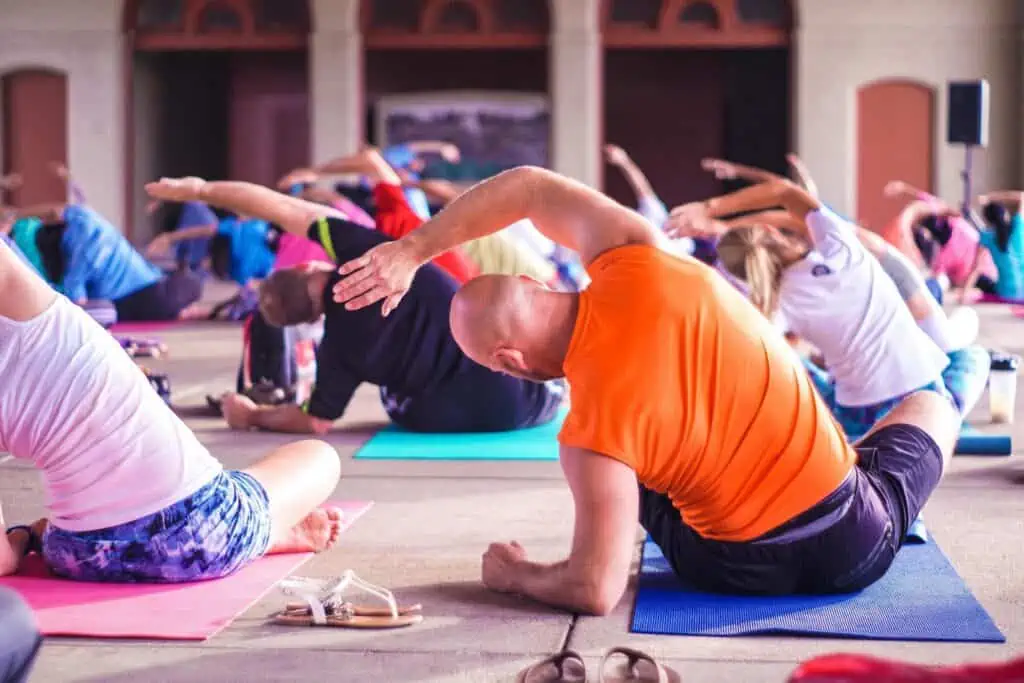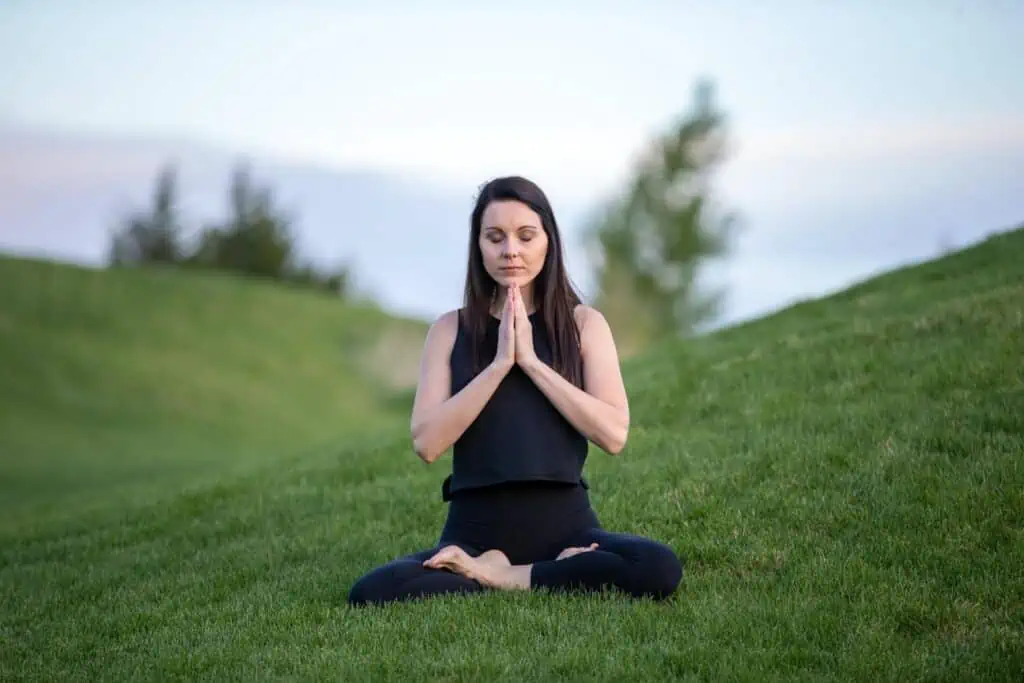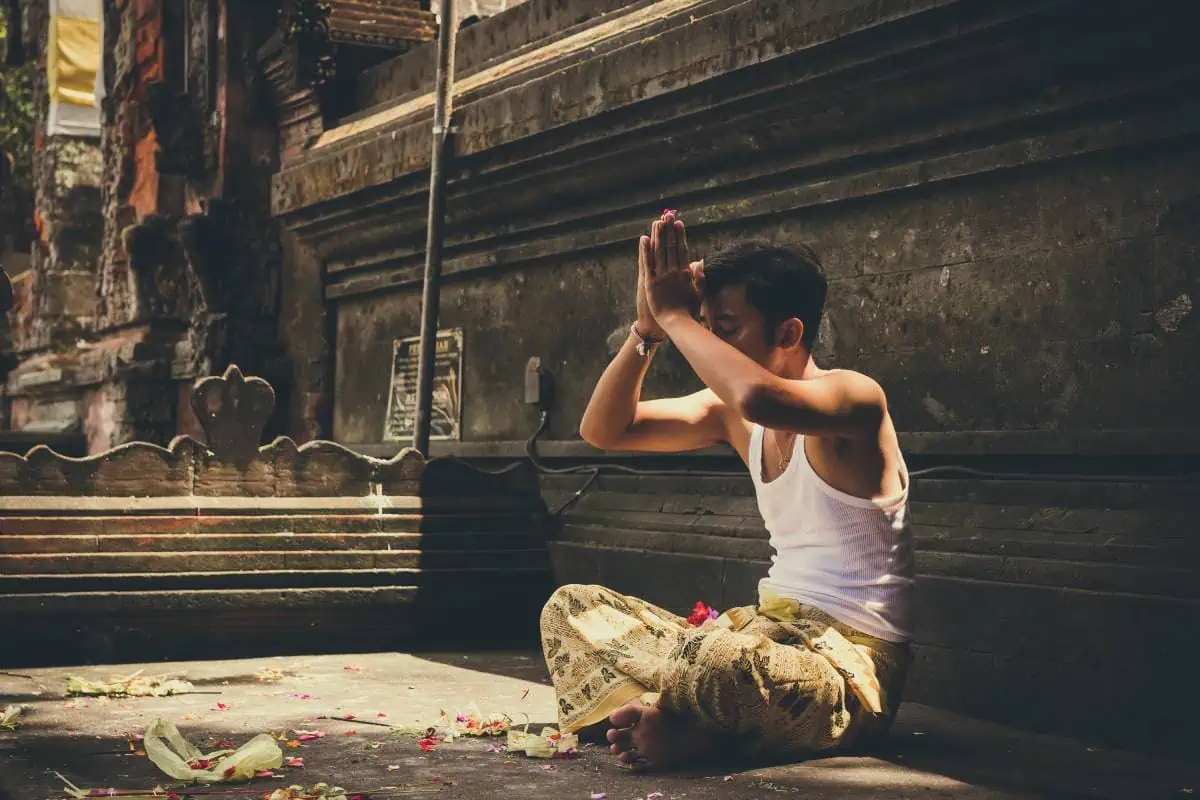What motivates you to roll out your yoga mat each day? If your answer includes the inner peace and mental focus achieved through dedicated practice, then you are practicing Raja Yoga.
There are many reasons why millions of people choose to practice yoga. Some arrive at their mat desiring to improve physical health through asana practice, while others seek more abstract benefits like mental clarity, emotional growth, and spiritual awareness. Indeed, yoga encompasses all of these aspects, yet many styles emphasize specific goals within the broader practice.
Vinyasa, Hatha, and Ashtanga are well-known and widely popular styles of yoga that focus primarily on physical postures. Here, we’ll dive into Raja Yoga, which focuses on meditation and mental discipline.
Raja Yoga translates roughly to the “royal path” (with “raja” meaning “king” in Sanskrit) and aims to achieve unification with the divine. In other words, the objective of Raja Yoga is to attain inner peace through mastery over the mind.
Understanding the fundamentals of Raja Yoga can profoundly transform your yoga practice, whether you’re a beginner or already have an established routine. Together, let’s embark on this journey towards inner harmony.
Contents
- 1 The Royal Path of Raja Yoga
- 2 Ashtanga Yoga. The Eight Limbs of Raja Yoga
- 3 Meditation: The Essence of Raja Yoga
- 4 Balancing Your Practice with Hatha and Karma Yoga
- 5 Integrating Bhakti and Jnana Yoga to Your Practice
- 6 Modern Asanas and Embracing Traditional Practice
- 7 Spiritual Growth through Ancient Teachings
- 8 Raja Yoga FAQs
- 9 Final Thoughts
The Royal Path of Raja Yoga
Raja Yoga, also known as the “royal path,” is a practice founded on yoga philosophy. This structured approach to spiritual growth has deep historical roots but remains relevant in our modern world. It provides an antidote to excessive thinking and extreme materialism.
Sage Patanjali and the Raja Yoga Sutras
To fully appreciate the intention of Raja Yoga requires understanding Sage Patanjali’s teachings and familiarity with his significant work, The Yoga Sutras. Furthermore, you must be willing to apply these sutras for self-realization through meditation and ethical living.
Patanjali’s wisdom is a guiding light for numerous seekers on their path toward spiritual awakening. His practical techniques and philosophical insights bridge ancient wisdom with modern life.
Raja Yoga helps us find balance in our fast-paced world dominated by materialism. It encourages us to seek internal reflection rather than relying solely on external fulfillment. Timeless wisdom lies within Patanjali’s teachings, capable of transforming lives even in today’s diverse cultures and eras.
To learn how to put these broad ideas into practice, let us explore another facet of Raja Yoga: the eight-limbed path of Ashtanga yoga.
Ashtanga Yoga. The Eight Limbs of Raja Yoga
In the realm of Raja Yoga, Ashtanga holds a significant place. Introduced by Patanjali in his Yoga Sutras, Ashtanga yoga offers a step-by-step guide to purifying the mind and body, leading the practitioner toward enlightenment.
The Eight Limbs include:
- Yama: moral principles.
- Niyama: personal conduct.
- Asana: physical postures.
- Pranayama: breath control practices.
- Pratyahara: control of the senses.
- Dharana: one-pointed focus (concentration).
- Dhyana: meditation.
- Samadhi: unification with the divine.
Many common forms of yoga include practices focused on the first four limbs. By contrast, Raja Yoga concentrates on the final four, taking you on a journey within yourself.
Pratyahara to Samadhi: Exploring the Inner Path
According to Patanjali’s sutras, the fifth stage is Pratyahara, which involves withdrawing from external distractions and directing our focus inward. This helps us better understand ourselves and our connection with the universe.
Moving forward on this path is Dharana, where concentration becomes paramount. Practitioners learn to center their attention on a single object without any distractions. This steady concentration brings us into the meditative state of Dhyana.
True meditation entails uninterrupted contemplation in its purest form. Through regular practice, Dhyana leads eventually to Samadhi. In this progression, the individual consciousness merges with the universal, leading to profound peace and blissful experiences.
These internal stages guide practitioners on an inner journey leading to enlightenment. They are essential components of Raja Yoga: Pratyahara, Dharana, and Dhyana, culminating in Samadhi. All are centered around a single object and focus on the individual’s inner experience.
Now, let’s expand upon how yoga meditation serves as the core principle of Raja Yoga.
Meditation: The Essence of Raja Yoga

Raja Yoga places great importance on meditation, which aims to cultivate a focused mind and nurture spiritual awareness.
Practice Meditation Anytime, Anywhere
According to Swami Vivekananda, Raja Yoga meditation has a unique quality in its adaptability. You can practice this form of meditation anywhere and at any time, even if your eyes are open.
The key is to direct your focus inward, regardless of any external circumstances or distractions around you. The essence of Raja yoga lies in achieving mental clarity by reducing scattered thoughts and enhancing concentration.
To develop a focused mind:
- Immerse yourself deeply in this process, cultivating stillness of mind (one-pointed focus).
- Practice regularly to experience increased calmness and reduced stress levels — signs that you are progressing towards attaining inner peace.
- Acknowledge the connection between yourself and everything that surrounds you. This promotes the sense of unification with the divine, the ultimate goal as you practice Raja yoga.
- Observe subtle changes within yourself and shifts in your perception of the outside world as you progress through the different phases of this meditative practice.
Raja yoga teaches the practitioner to immerse themselves fully in their own experience. Now, let’s briefly examine other practices like Hatha and Karma yoga that beautifully complement the inward-looking discipline of Raja yoga.
Balancing Your Practice with Hatha and Karma Yoga
All yoga encompasses teachings of the eight-fold path; however, the emphasis shifts across different styles. While Raja yoga is more of an internal yoga meditation practice, Hatha and Karma yoga direct energy externally.
Hatha yoga strongly emphasizes practicing postures, known as asanas, to improve strength, flexibility, and balance while promoting relaxation. By incorporating breath control techniques, Hatha Yoga aids in stress management by calming the nervous system. It offers numerous benefits, such as improved cardiovascular fitness, reduced back pain, and better sleep quality.
In contrast, Karma Yoga, often called the ‘yoga of action,’ encourages selfless service without expecting anything in return. This spiritual approach nurtures humility, patience, and compassion through detached work. The ultimate goal is to attain liberation from the cycle of birth and death, closely aligning with Hindu philosophical teachings.
The practices of Karma Yoga enhance life force energy by teaching us to perform our duties sincerely without attachment to the outcomes. Such detachment leads to inner peace regardless of external circumstances.
By incorporating both these forms into your routine along with Raja Yoga, you can experience multidimensional benefits, whether maintaining good health or progressing spiritually.
To continue exploring complementary yoga practices, let’s move on to Bhakti and Jnana, two branches that play significant roles when incorporated into comprehensive practices like those offered by Raja Yoga.
Integrating Bhakti and Jnana Yoga to Your Practice
Combining Jnana Yoga (the path of knowledge) and Bhakti Yoga (devotion to the divine) within your comprehensive practice of Raja can genuinely enhance your journey through yoga. Each one contributes uniquely towards achieving heightened consciousness.
Bhakti Yoga focuses on cultivating a deep emotional connection beyond worldly attachments. It revolves around the love for divinity. By incorporating this approach into your regular Raja Yoga practice, you develop mental discipline and create space for profound spiritual connection.
On the other hand, Jnana Yoga takes a different path by emphasizing wisdom and discernment. This form of yoga encourages introspection and analysis as tools for understanding oneself beyond the physical realm.
By blending elements from both Bhakti and Jnana Yogas, you can enrich your experience of Raja Yoga, opening up new avenues for exploration. It combines devotion and self-realization through intellectual pursuits.
While each path has its merits, they are not mutually exclusive but complement each other beautifully. Together, they guide us towards our ultimate goal – Samadhi or unified consciousness, as per Raja Yoga philosophy.
By learning about these ancient philosophies and incorporating them into our modern asana practice, we respect the time-honored traditions of yoga.
Modern Asanas and Embracing Traditional Practice

The contemporary yoga landscape offers a diverse collection of modern asanas and structured classes that have evolved while staying rooted in tradition.
These elements not only introduce the principles of traditional Raja Yoga but also provide numerous benefits for physical well-being.
Although they do not cover all aspects of Raja Yoga, these adaptations play a vital role in promoting mental calmness. Practicing regularly allows yogis to gain control over their breath and body movements, which are essential for attaining inner peace.
Engaging in modern asanas, such as Sun Salutations or Warrior poses, can significantly improve strength and flexibility while enhancing body awareness — crucial for more profound yogic practices like meditation.
In contemporary yoga classes, instructors guide students through sequences that cultivate mindfulness and foster community among participants. This group dynamic often motivates individuals to maintain consistency in their practice compared to practicing alone at home.
From Modern to Traditional
Transitioning from modern techniques to traditional forms requires openness and dedication on your personal yoga journey. Embrace your current position while remaining curious about learning advanced techniques gradually.
Drawing insights from ancient Vedic scriptures further deepens our understanding of how these time-honored teachings align perfectly with the principles advocated by Raja Yoga.
Spiritual Growth through Ancient Teachings
Applying the teachings from the Bhagavad Gita for spiritual growth is a profound endeavor. This revered Hindu scripture aligns closely with the principles of Raja Yoga, emphasizing the importance of fulfilling one’s duty without becoming attached to the outcomes.
This essential teaching resonates deeply with the core values of Raja Yoga, which encourage practitioners to fully engage in their actions while maintaining an inner detachment from results. By embracing this approach, individuals can cultivate a sense of balance and tranquility regardless of whether they achieve success or encounter failure.
The principle of duty without attachment offers us a path to live an action-oriented life free from being consumed by concerns about outcomes. This can be a significant source of stress and anxiety in contemporary society.
Another fundamental lesson from the Bhagavad Gita emphasizes recognizing ourselves as eternal souls rather than solely identifying with our physical form or mental constructs. By understanding our divine nature, we can transcend materialistic achievements and embark on a journey toward self-realization through introspection. These objectives lie at the heart of Raja Yoga’s practice.
Raja Yoga practitioners who integrate these insights into their daily routines can experience increased inner peace amidst worldly chaos. The timeless wisdom offered by the Bhagavad Gita and Raja Yoga is a guiding light towards spiritual enlightenment.

Raja Yoga FAQs
What does practicing Raja Yoga entail?
Raja Yoga, often called the “royal path,” involves meditation and introspection to achieve spiritual enlightenment and inner peace. Practitioners follow a comprehensive eight-step process that includes moral codes, postures, breath control, sensory withdrawal, concentration, and meditation. This holistic approach leads to a deep sense of spiritual unity.
Is Raja Yoga suitable for people who are new to it?
Definitely! Although it requires discipline and commitment, beginners can practice Raja Yoga with proper guidance.
How does Raja Yoga differ from Hatha Yoga?
While Hatha yoga primarily focuses on physical postures, Raja yoga emphasizes mental control achieved through meditation, leading to spiritual growth.
Final Thoughts
Exploring Raja Yoga opens up a world of spiritual growth and inner peace. This ancient practice provides a systematic approach toward enlightenment. What makes Raja Yoga beautiful is its systematic approach to spirituality. Each step along this royal path brings you closer to self-realization and ultimate liberation.
Meditation is at the heart of raja yoga. It transcends everyday consciousness, leading us towards true empowerment on all levels – physical health, mental clarity, life force energy, and emotional stability.
Raja Yoga’s benefits extend beyond personal transformation; they seep into our relationships, fostering positive changes around us while enabling self-actualization through a better understanding of one’s true nature.
Incorporating principles and practices of Raga Yoga into a daily routine helps balance materialistic tendencies with spiritual pursuits for holistic well-being.
If you’re ready to journey towards inner unity through Raja Yoga or to deepen your existing practice, The Yoga Nomads are here for you! We offer diverse resources ranging from props to support your meditation practice to deeper insights about spirituality, chakras, and yoga pose tutorials.


